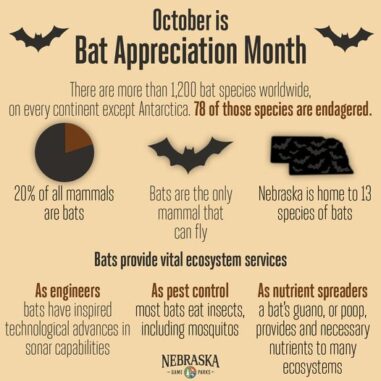
Bats and snakes are wonderful creatures that are vital to the Nebraska ecosystem. Unfortunately, they get a bad reputation for being “creepy”. A snake slithering through your garden may be an unwelcome surprise as you are pulling weeds, but before you panic or do any harm to the snake, remember all the good he can offer.
Snakes can provide many benefits to our environment. Most importantly they play a vital role in the food chain, and they are a key part of a balanced ecosystem. Snakes are both predator and prey. This means they eat small rodents, insects, amphibians, worms, etc. Snakes are a wonderful form of natural pest control in our gardens. Populations of rabbits, insects and other pests that disturb our plantings can be kept down by snakes. As prey, snakes are also eaten by other snakes, large birds of prey and sometimes even squirrels. These larger predators help keep the snake population from booming. In a well-balanced ecosystem, each predator keeps the lower level of prey in check. Birds keep snakes from becoming too abundant and snakes keep rodents and insects from infesting.
While there are venomous snakes that deserve our respect and distance, the majority of snakes found in Nebraska are not poisonous. Especially in the Omaha area, we have a less diverse snake population than the western parts of the state. The snakes most commonly found in urban yards are garter snakes. Garter snakes are often fairly small but can grow up to 52” long. Garter snakes have dark heads and dark bodies with bright yellow, cream, or red colored stripes running down the length of their body. There are multiple species of garter snakes and they can vary in appearance. Here is a link with more information about the types of snakes found in Nebraska, and how to identify them: https://herpneb.unl.edu/snake-identification
Along with the variety of snake species, there are 13 species of bats that live in Nebraska. The most common bat found in urban settings is the Big Brown bat. The big brown bat has brown fur on its body and black skin on its nose and wings. From head to tail, the bat is about 5” long and has a wingspan about 3x that. These bats, as well as all other species of bats found in Nebraska, only eat insects. There are hundreds of other bat species across the world, some of which pollinate flowers and eat fruits. These flying mammals have a worldwide impact.
Bats are most active around dusk, as they emerge from their hideaways to start munching on bugs. If you happen to glance up as the sun goes down, you may well catch a glimpse of these fascinating creatures darting and diving across the sky. They feed on insects like mosquitoes, leafhoppers, June beetles and stink bugs. Bats can eat more than their own body weight in insects. This means that bats are making quite a dent in the number of mosquitoes left flying around to pester us–and not just mosquitoes, but also herbivorous insects that can damage our crops and landscapes.
Another benefit provided by bats is that their feces (guano) is a wonderful fertilizer. Bat guano is not only rich in nitrogen, but contains phosphorus and potassium as well. If you have bats flying around your yard at night their droppings will end up in your yard or garden and your plants are fertilized with no extra work. You can also purchase bat guano as an organic fertilizer. Just be sure to handle carefully to avoid inhaling dust; bat guano can grow a fungus given the right environment.
While bats present little harm to humans, they can sometimes invade our spaces. The Nebraska extension office provides more information about bats, and what you can do if you have bats living in/around your house: https://wildlife.unl.edu/pdfs/bats-in-around-structures.pdf
If you see any snakes or bats around your property, do not fear. They are playing their role in the local habitat. The presence of these animals even suggests you have a healthy ecosystem in your yard! The best option is to let the critters be, and peaceably coexist as best you can.








